Death Valley is the largest National Park in the continental U.S., comprising over 3.3 million acres of spectacular desert scenery, rare desert wildlife, complex geological strata, and sites of historical interest.
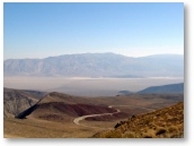 Over 3 million of its acres are undisturbed wilderness. Death Valley's vast natural beauty and scientific importance were first brought to the attention of the National Park Service in the late 1920s. With the support of Stephen T. Mather, the first Director of the National Park Service, Death Valley was proclaimed a National Monument on February 11, 1933. Because of its “mosaic of ecological systems”, in 1984 Death Valley was designated a Biosphere Reserve, an international classification granted to only 530 other places on earth. As a National Monument, Death Valley was expanded several times from its original 2 million acres. Then, with the passage of the California Desert Protection Act of 1994, 1.2 million
acres were added, and Death Valley was upgraded in status to a National Park encompassing 3,336,000 acres.
Over 3 million of its acres are undisturbed wilderness. Death Valley's vast natural beauty and scientific importance were first brought to the attention of the National Park Service in the late 1920s. With the support of Stephen T. Mather, the first Director of the National Park Service, Death Valley was proclaimed a National Monument on February 11, 1933. Because of its “mosaic of ecological systems”, in 1984 Death Valley was designated a Biosphere Reserve, an international classification granted to only 530 other places on earth. As a National Monument, Death Valley was expanded several times from its original 2 million acres. Then, with the passage of the California Desert Protection Act of 1994, 1.2 million
acres were added, and Death Valley was upgraded in status to a National Park encompassing 3,336,000 acres.
Death Valley is a land of extremes and unique in a number of ways. Approximately 550 square miles of its area lie below sea level, and it contains the lowest, the hottest, and the driest locations in North America. The lowest point in North America, as well as the entire Western Hemisphere, is 282 feet below sea level, and is located at Death Valley's Badwater
Basin. As the hottest place in North America, Death Valley's summer temperatures average well over 100 degrees Fahrenheit. In 1913, Death Valley's temperature reached 134 degrees Fahrenheit, the highest temperature ever recorded on earth. (This temperature now represents the world's second-highest, as Libya reached 136 degrees Fahrenheit in 1936.) An average annual rainfall of only 1.96 inches, with some years having no measurable rainfall, makes Death Valley the driest place in North America. Both the extreme heat and low rainfall in Death Valley are due primarily to its being encircled by numerous high-rising peaks of the Panamint Range Mountains, the highest being 11,049-foot Telescope Peak.
Death Valley is a treasure trove of scientific information about ancient Earth and the natural geological forces still working to shape our world. As glaciers retreated from the Sierra Nevada at the end of the last ice age, about 10,000 years ago, Death Valley became a lake filled with abundant water and life.
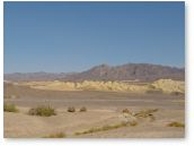 The teeming life of this and other fresh water lakes fed the ancestors of the modern Shoshone and Piute who made their homes along the lakeshores and in the nearby mountains. Over time, the climate became more arid and the lakes slowly dried up. The Shoshone crowded around the few remaining freshwater springs that bubbled out of the ground along the base of the
Funeral Mountains. Villages grew around each major spring, and the largest of all, Timbisha, was located at present-day Furnace Creek. Vestiges of man's presence through the ages can be seen in almost every part of Death Valley, and rock drawings, campsites and foot trails remain as evidence of pre-historic hunters and gatherers. Descendants of the original
Shoshone continued to adapt to this land of extremes, and it was the Shoshone-speaking Panamint Indians who were there when pioneer wagons arrived in the mid-1800s.
The teeming life of this and other fresh water lakes fed the ancestors of the modern Shoshone and Piute who made their homes along the lakeshores and in the nearby mountains. Over time, the climate became more arid and the lakes slowly dried up. The Shoshone crowded around the few remaining freshwater springs that bubbled out of the ground along the base of the
Funeral Mountains. Villages grew around each major spring, and the largest of all, Timbisha, was located at present-day Furnace Creek. Vestiges of man's presence through the ages can be seen in almost every part of Death Valley, and rock drawings, campsites and foot trails remain as evidence of pre-historic hunters and gatherers. Descendants of the original
Shoshone continued to adapt to this land of extremes, and it was the Shoshone-speaking Panamint Indians who were there when pioneer wagons arrived in the mid-1800s.
The first white men entered Death Valley on Christmas Day 1849, looking for a short-cut to the gold fields of California. These "Forty Niners" began their exploits in the Valley and were followed by successive invasions of prospectors seeking to mine the deposits of silver and other precious metals rumored to exist in the Valley. One of Death Valley’s largest
prospecting booms was the search for the Lost Gunsight Silver lode, a supposed mountain ledge of silver from which a prospector had removed a piece of metal to replace his rifle’s missing gunsight. For several decades, silver-seeking prospectors came to the Valley, but the Lost Gunsight lode was never found again. With each ore strike, a new settlement
was born, but all were short-lived. Even the discovery of borax, the "white gold of the desert", failed to support a permanent community. The 1849 chapter of Death Valley history is filled with tales of hardship and fatalities. Of the original party of 30 Forty-Niners, only 18 survived. Some of these survivors were forced to slaughter their oxen for
food, burn their wagons and proceed on foot seeking a trail westward out of the Valley. Those that left gave the area its name, crying out "Good-bye, Death Valley" as they happily put the brutal landscape behind them.
Although there is a long history of prospecting and mining in Death Valley, only a handful of the prospectors met with any success;
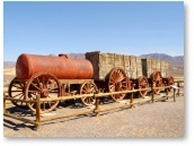 but many interesting stories surround the few whose dreams did come true. The most famous and perhaps most flamboyant of all prospectors was Death Valley Scotty, a colorful personality whose tales and exploits helped publicize the Valley. Born Walter E. Scott, “Scotty” first came to the Valley in 1884 as part of a crew surveying the California-Nevada border. The following year Scotty took a job with Harmony Borax Works, the best known mining operation in the Valley, and worked there for about three years.
but many interesting stories surround the few whose dreams did come true. The most famous and perhaps most flamboyant of all prospectors was Death Valley Scotty, a colorful personality whose tales and exploits helped publicize the Valley. Born Walter E. Scott, “Scotty” first came to the Valley in 1884 as part of a crew surveying the California-Nevada border. The following year Scotty took a job with Harmony Borax Works, the best known mining operation in the Valley, and worked there for about three years.
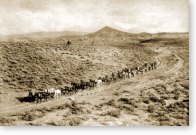 Built by William Tell Coleman in 1882 and located just north of Furnace Creek, Harmony Borax was the site from which the famous 20-mule borax teams hauled their loads (up to 23 tons at a time) 165 grueling miles to the railroad in Mojave. Harmony was the first successful borax works in the history of borax mining in Death Valley, and its old boiler and some of
the vats still stand among the operation's crumbling adobe walls. Despite the existence of more deposits in the area, Harmony Borax shut down operation in 1890 and transferred to Daggett in the Calico Mountains to be closer to the railroad.
Built by William Tell Coleman in 1882 and located just north of Furnace Creek, Harmony Borax was the site from which the famous 20-mule borax teams hauled their loads (up to 23 tons at a time) 165 grueling miles to the railroad in Mojave. Harmony was the first successful borax works in the history of borax mining in Death Valley, and its old boiler and some of
the vats still stand among the operation's crumbling adobe walls. Despite the existence of more deposits in the area, Harmony Borax shut down operation in 1890 and transferred to Daggett in the Calico Mountains to be closer to the railroad.
A popular attraction in Death Valley is the 32,000 square-foot Scotty’s Castle, which was built in the late 1920s by Chicago millionaire Albert Johnson as a winter home for him and his wife.
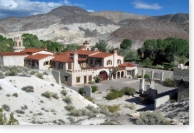 In 1922, Death Valley Scotty had convinced Johnson to invest in a Valley gold mine that he fraudulently claimed to have found. The many visits that Johnson made to the hot, arid region in search of the nonexistent mine were extremely beneficial to his health, and this probably explains why Johnson remained friends with the underhanded Scotty. It was after Johnson and his wife, Bessie, had made several trips to Death Valley that Bessie suggested they build a winter vacation home there. Originally called Death Valley Ranch, the Johnson’s villa cost about $2 million and was a showcase of technological innovations, complete with a system of underground tunnels. Scotty’s proclamations that the ranch was built with gold from his mine led to its being called “Scotty’s Castle”. Walter Scott died in 1954 and was buried in the hill overlooking the famed “Castle” that he neither owned nor helped build, but which nonetheless bears his name. Scotty’s Castle was bought by the National Park Service in 1970.
In 1922, Death Valley Scotty had convinced Johnson to invest in a Valley gold mine that he fraudulently claimed to have found. The many visits that Johnson made to the hot, arid region in search of the nonexistent mine were extremely beneficial to his health, and this probably explains why Johnson remained friends with the underhanded Scotty. It was after Johnson and his wife, Bessie, had made several trips to Death Valley that Bessie suggested they build a winter vacation home there. Originally called Death Valley Ranch, the Johnson’s villa cost about $2 million and was a showcase of technological innovations, complete with a system of underground tunnels. Scotty’s proclamations that the ranch was built with gold from his mine led to its being called “Scotty’s Castle”. Walter Scott died in 1954 and was buried in the hill overlooking the famed “Castle” that he neither owned nor helped build, but which nonetheless bears his name. Scotty’s Castle was bought by the National Park Service in 1970.
The 20-mule team borax train became a television icon in the popular anthology Death Valley Days, which ran for 18 seasons (558 episodes) from 1952 to 1970. The series dramatized incidents in the lives of residents of Nevada and California during the late 1800s.
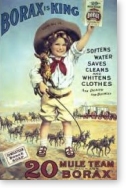 One of the longest-running programs in television history, Death Valley Days was originally a radio program created in 1930 by Ruth Woodman, a New York advertising agency scriptwriter. Woodman was hired to develop a radio show by the sponsor 20 Mule Team Borax, and it was her idea to write a story with ties to the product. Often spending months at a time in the Valley and surrounding areas, Woodman’s on-location research enabled her to write realistic and fact-based stories that revolved around the legends and lore of Death Valley. The beloved series reflected human interest dramas from the days when miners and homesteaders first fanned across the West in search of a better way of life during the California Gold Rush. The radio program ran from 1931 to 1945 before moving to television in 1952, with Woodman serving as story editor and chief writer until she retired in 1959. Hundreds of actors appeared in the series. Most of the actors were unknowns, and some would become famous; but the emphasis of the program was on the story. The only series regular was the host and narrator, and the original and longest-running one was Stanley Andrews as "The Old Ranger" (1952-1965). Other stars to host the series included Ronald Reagan (1965-1966), Robert Taylor (1966-1968), and Dale Robertson (1968-1970). Another television anthology to utilize Death Valley's magnificent landscape was The Twilight Zone, with several of its episodes being filmed there.
One of the longest-running programs in television history, Death Valley Days was originally a radio program created in 1930 by Ruth Woodman, a New York advertising agency scriptwriter. Woodman was hired to develop a radio show by the sponsor 20 Mule Team Borax, and it was her idea to write a story with ties to the product. Often spending months at a time in the Valley and surrounding areas, Woodman’s on-location research enabled her to write realistic and fact-based stories that revolved around the legends and lore of Death Valley. The beloved series reflected human interest dramas from the days when miners and homesteaders first fanned across the West in search of a better way of life during the California Gold Rush. The radio program ran from 1931 to 1945 before moving to television in 1952, with Woodman serving as story editor and chief writer until she retired in 1959. Hundreds of actors appeared in the series. Most of the actors were unknowns, and some would become famous; but the emphasis of the program was on the story. The only series regular was the host and narrator, and the original and longest-running one was Stanley Andrews as "The Old Ranger" (1952-1965). Other stars to host the series included Ronald Reagan (1965-1966), Robert Taylor (1966-1968), and Dale Robertson (1968-1970). Another television anthology to utilize Death Valley's magnificent landscape was The Twilight Zone, with several of its episodes being filmed there.
Prior to television, the entertainment industry was already well acquainted with the spectacular desert scenery of Death Valley. Many of the Hollywood filmmakers had at one time or
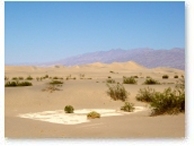 another used Death Valley as a backdrop for many of their movies. Death Valley appears on the screen in one of three ways: in title only, in location only, or in both title and location. In the first type, the film has "Death Valley" in its title, but the subject matter or plot has nothing to do with the actual location. In the second type, the film title has no mention of Death Valley, but the scenery is recognizable as being shot on location. And in the third type, the title includes "Death Valley" and filming is unmistakably on location in Death Valley. Many films of the last century fall into one of these three categories. Hollywood's fascination for Death Valley stems from the area's diverse scenery that ranges from sun-baked valley floors to snow-capped mountain ridges, with sand dunes in between. Consequently, Death Valley can be portrayed on the screen in a variety of ways, but is best suited for western themes, desert adventures, and even science
another used Death Valley as a backdrop for many of their movies. Death Valley appears on the screen in one of three ways: in title only, in location only, or in both title and location. In the first type, the film has "Death Valley" in its title, but the subject matter or plot has nothing to do with the actual location. In the second type, the film title has no mention of Death Valley, but the scenery is recognizable as being shot on location. And in the third type, the title includes "Death Valley" and filming is unmistakably on location in Death Valley. Many films of the last century fall into one of these three categories. Hollywood's fascination for Death Valley stems from the area's diverse scenery that ranges from sun-baked valley floors to snow-capped mountain ridges, with sand dunes in between. Consequently, Death Valley can be portrayed on the screen in a variety of ways, but is best suited for western themes, desert adventures, and even science
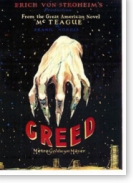 fiction. By far the majority of films shot in Death Valley have been Westerns. Perhaps the first time Death Valley appeared on the screen was in the Western short Death Valley Scotty's Mine (1912), starring Walter Scott portraying himself in the title role. This was followed by Cecil B. DeMille's Chimmie Fadden Out West (1915) starring Victor Moore and Camille Astor. Other silent Westerns that were filmed in Death Valley include Jack Holt's Wanderer of the Wasteland (1924) and The Water Hole (1928), Ken Maynard's The Unknown Cavalier (1926), and Monte Blue's The Brute (1927). A number of non-Western silent films also used Death Valley as a backdrop, but the most famous and one of the greatest was Erich von Stroheim's Greed (1924), the powerful adaptation of Frank Norris' novel McTeague, starring Gibson Gowland and ZaSu Pitts. This film tells the story of a simple man whose wife's obsession with money eventually drives him into madness. The final sequences of the film were shot in Death Valley and are unforgettable.
fiction. By far the majority of films shot in Death Valley have been Westerns. Perhaps the first time Death Valley appeared on the screen was in the Western short Death Valley Scotty's Mine (1912), starring Walter Scott portraying himself in the title role. This was followed by Cecil B. DeMille's Chimmie Fadden Out West (1915) starring Victor Moore and Camille Astor. Other silent Westerns that were filmed in Death Valley include Jack Holt's Wanderer of the Wasteland (1924) and The Water Hole (1928), Ken Maynard's The Unknown Cavalier (1926), and Monte Blue's The Brute (1927). A number of non-Western silent films also used Death Valley as a backdrop, but the most famous and one of the greatest was Erich von Stroheim's Greed (1924), the powerful adaptation of Frank Norris' novel McTeague, starring Gibson Gowland and ZaSu Pitts. This film tells the story of a simple man whose wife's obsession with money eventually drives him into madness. The final sequences of the film were shot in Death Valley and are unforgettable.
With the advent of talking pictures, Westerns continued to be filmed in Death Valley for the next four decades. In the 1930s, several B-Westerns were filmed in Death Valley including Universal's The Rider of Death Valley (1932) starring Tom Mix, and Monogram's Where Trails Divide (1937) starring Tom Keene.
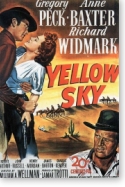 In Metro-Goldwyn-Mayer's 20 Mule Team (1940), starring Wallace Beery and Leo Carrillo, most of the exteriors were shot on location and the black and white scenery is spectacular. The story plot follows the exploits of borax miner Beery, with Piute sidekick Carrillo, in 1892 Death Valley as the yields of borax were decreasing. Anne Baxter made her debut in this film. In the late 1940s, there were several bigger-budget, A-Western entries that used Death Valley: John Ford's 3 Godfathers (1948) starring John Wayne and Pedro Armendariz; John Sturges' The Walking Hills (1949) starring Randolph Scott and Ella Raines; and William A. Wellman's Yellow Sky (1949) starring Gregory Peck and Anne Baxter. Death Valley was not, however, the principal location site for Yellow Sky; most filming was done in Lone Pine, California. A sampling of movies from the 1950s that were made in Death Valley include 20th Century Fox's The Gunfighter (1950) directed by Henry King and starring Gregory Peck and Helen Westcott; Universal International's Cattle Drive (1951) directed by Kurt Neumann and starring Joel McCrea and Dean Stockwell; Metro-Goldwyn-Mayer's Escape from Fort Bravo (1954) starring William Holden and Eleanor Parker, and The Law and Jake Wade (1958) starring Robert Taylor and Richard Widmark, both directed by John Sturges. In the decade that followed, the overall demand for Westerns began to wind down, and there was a shift toward action dramas and sci-fi. The few Westerns to use Death Valley in the 1960s include Marlon Brando's One-Eyed Jacks (1961) and Richard Brooks' The Professionals (1966).
In Metro-Goldwyn-Mayer's 20 Mule Team (1940), starring Wallace Beery and Leo Carrillo, most of the exteriors were shot on location and the black and white scenery is spectacular. The story plot follows the exploits of borax miner Beery, with Piute sidekick Carrillo, in 1892 Death Valley as the yields of borax were decreasing. Anne Baxter made her debut in this film. In the late 1940s, there were several bigger-budget, A-Western entries that used Death Valley: John Ford's 3 Godfathers (1948) starring John Wayne and Pedro Armendariz; John Sturges' The Walking Hills (1949) starring Randolph Scott and Ella Raines; and William A. Wellman's Yellow Sky (1949) starring Gregory Peck and Anne Baxter. Death Valley was not, however, the principal location site for Yellow Sky; most filming was done in Lone Pine, California. A sampling of movies from the 1950s that were made in Death Valley include 20th Century Fox's The Gunfighter (1950) directed by Henry King and starring Gregory Peck and Helen Westcott; Universal International's Cattle Drive (1951) directed by Kurt Neumann and starring Joel McCrea and Dean Stockwell; Metro-Goldwyn-Mayer's Escape from Fort Bravo (1954) starring William Holden and Eleanor Parker, and The Law and Jake Wade (1958) starring Robert Taylor and Richard Widmark, both directed by John Sturges. In the decade that followed, the overall demand for Westerns began to wind down, and there was a shift toward action dramas and sci-fi. The few Westerns to use Death Valley in the 1960s include Marlon Brando's One-Eyed Jacks (1961) and Richard Brooks' The Professionals (1966).
Some of the major action flicks to be filmed in Death Valley during the 1960s-1990s include the two biblical classics Spartacus (1960) starring Kirk Douglas and The Greatest Story Ever Told (1965) starring Max von Sydow; Winter Kills (1979) starring Jeff Bridges;
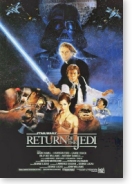 The Oasis (1984) starring Chris Makepeace; The Hitcher (1986) starring C. Thomas Howell; Delusion (1991) starring Jim Metzler; Stripshow (1996) starring Tane McClure; and Welcome to Serendipity (1998) starring Irene Barnett. The sci-fi genre evolved in the 1950s when the reality of space exploration sparked everyone's imagination, and Death Valley was an excellent locale to depict the barren landscapes of distant planets. Sci-fi productions with scenes filmed in Death Valley include Rocketship X-M (1950) starring Lloyd Bridges; Robinson Crusoe on Mars (1964) starring Paul Mantee; Star Wars (1977) and Star Wars: Episode VI - Return of the Jedi (1983), both starring Mark Hamill and Harrison Ford; and more recently Bleak Feature (1997) starring Frank Kowal. In the two Star Wars epics, the colorful sand dunes and Jabba the Hut's lair scenes were filmed in Death Valley. A number of adventure flicks have also made use of Death Valley's diverse desert scenery: King Solomon's Mines (1950) starring Stewart Granger, The Golden Horde (1951) starring David Farrar, Tarzan's Peril (1951) starring Lex Barker, and Desert Hell (1958) starring Brian Keith.
The Oasis (1984) starring Chris Makepeace; The Hitcher (1986) starring C. Thomas Howell; Delusion (1991) starring Jim Metzler; Stripshow (1996) starring Tane McClure; and Welcome to Serendipity (1998) starring Irene Barnett. The sci-fi genre evolved in the 1950s when the reality of space exploration sparked everyone's imagination, and Death Valley was an excellent locale to depict the barren landscapes of distant planets. Sci-fi productions with scenes filmed in Death Valley include Rocketship X-M (1950) starring Lloyd Bridges; Robinson Crusoe on Mars (1964) starring Paul Mantee; Star Wars (1977) and Star Wars: Episode VI - Return of the Jedi (1983), both starring Mark Hamill and Harrison Ford; and more recently Bleak Feature (1997) starring Frank Kowal. In the two Star Wars epics, the colorful sand dunes and Jabba the Hut's lair scenes were filmed in Death Valley. A number of adventure flicks have also made use of Death Valley's diverse desert scenery: King Solomon's Mines (1950) starring Stewart Granger, The Golden Horde (1951) starring David Farrar, Tarzan's Peril (1951) starring Lex Barker, and Desert Hell (1958) starring Brian Keith.
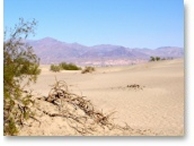 Of course, no film locale would be complete without at least one comedy having been filmed there. Although few in number, the comedies that have utilized Death Valley include The Bride Came C.O.D. (1941) starring James Cagney and Bette Davis, National Lampoon's Vacation (1983) starring Chevy Chase and Beverly D'Angelo, and Homer & Eddie (1989)
starring James Belushi and Jim Mapp.
Of course, no film locale would be complete without at least one comedy having been filmed there. Although few in number, the comedies that have utilized Death Valley include The Bride Came C.O.D. (1941) starring James Cagney and Bette Davis, National Lampoon's Vacation (1983) starring Chevy Chase and Beverly D'Angelo, and Homer & Eddie (1989)
starring James Belushi and Jim Mapp.
A beautiful land of extremes, Death Valley features a full variety of spectacular scenery. As evidenced on the silver screen, this unique diversity makes it a perfect on-location site for a wide spectrum of entertainment genres. To this day, Death Valley is a favorite film location for Hollywood's filmmakers.